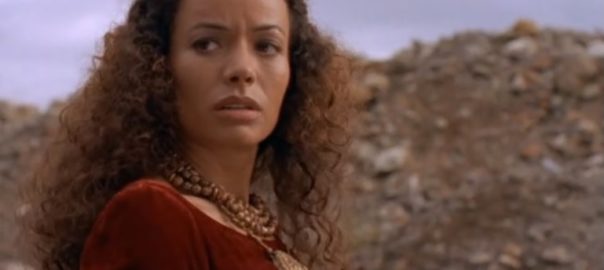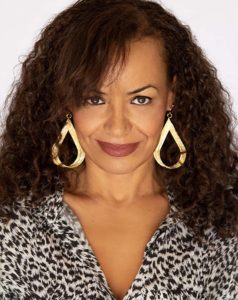 In Part 1 of our interview, Galyn Görg and I spoke about her early dance training, starring on the Italian variety show Fantastico, and the films Living the Blues, Dance Academy, RoboCop 2 and Point Break. Here in Part 2, we pick up with Twin Peaks, Galyn’s roles in science fiction and fantasy TV series including Star Trek: Deep Space Nine, Stargate SG-1, and Xena: Warrior Princess, and her arts education work with young people.
In Part 1 of our interview, Galyn Görg and I spoke about her early dance training, starring on the Italian variety show Fantastico, and the films Living the Blues, Dance Academy, RoboCop 2 and Point Break. Here in Part 2, we pick up with Twin Peaks, Galyn’s roles in science fiction and fantasy TV series including Star Trek: Deep Space Nine, Stargate SG-1, and Xena: Warrior Princess, and her arts education work with young people.
Adam: Last time we spoke, we ended on Point Break. It is probably timely to talk about Twin Peaks given the recent revival of Twin Peaks. You were on the second season of the original series. It had just blown up during its first season. What was it like to go into that phenomenon?
Galyn: It’s always interesting to watch a show and then have a part on it. Johanna Ray was the casting director. She always was a fan of mine and just so sweet to me. She called me up for so many things. David Lynch, I already knew who he was. As a director, I was somewhat in awe of him. It was great because I love that whole genre. The producer Mark Frost cast me after that in Storyville. I just had a communication with him recently. He was great. David was great. It’s so much fun creating art, and then when you get to work with people who are just kind and everyone’s supportive of each other. And Kyle MacLachlan’s cool, so it was a great experience. It’s like you’re stepping in and helping create this world, so I really enjoyed it. Sherilyn, I had that little bit with her, she was – everybody was really cool. I enjoyed it.
Adam: I love watching Sherilyn Fenn. Victoria Catlin, who played your sister, is someone I haven’t been able to find much about since Twin Peaks.
Galyn: Yeah.
Adam: This is probably a question that actors get asked a lot, but when you’re doing it, do you ever have a sense of what might stay around in the way that Twin Peaks has stayed around all these years?
Galyn: I had no idea. I didn’t know that it was going to be so successful. When the new Twin Peaks was coming out, I posted some shots of me on set of [the original] Twin Peaks. I think they got more ‘likes’ faster than anything I’ve ever posted, and I was shocked. It was shocking the amount of interest in that show all these years later. I had no idea that there was such an interest in it.
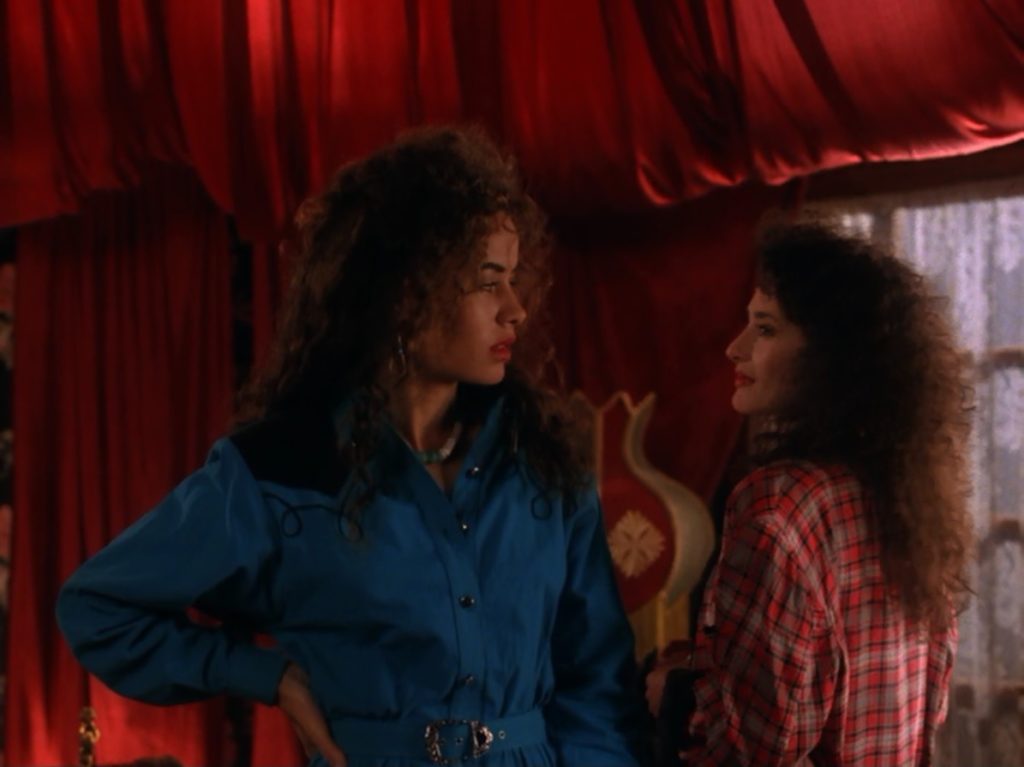
Adam: It must be a pretty pleasing feeling to have something like that. You do something, and then you keep working and doing other things and you kind of put it to one side, but then it’s still there all these years later.
Galyn: It’s great because you realise, Oh wow, people were watching. Just before I got on this call, I saw somebody was watching an old episode of Twin Peaks and they took a screenshot and tweeted it to me, “Galyn, there you are!” You do these things and then you forget.
Adam: From Twin Peaks you then got Storyville as a savvy, street-smart escort.
Galyn: I enjoyed that. Mark Frost put me through the audition process a little bit. I remember that I had to really work on that. We shot in New Orleans, or as my character would say, “N’Orlns”. I loved it because I had to really work on the accent. When I have a break in shooting, I always like to stand and talk to the grips or, you know, the guys behind the scene, and the local people from wherever I’m shooting. Then I’ll get some real feedback on how my accent is. They said, “Yeah, it’s good. It sounds authentic. You’re doing a good job”, so then I was like, OK, good. I want to get it from the real people.
Adam: You must have a thing for accents. You have the very natural Italian accent, and the very natural New Orleans accent.
Galyn: I love doing accents. I’m actually going to go to an improv workshop tonight, and I’ll try and do a bunch of accents, yeah.
Adam: In Storyville, New Orleans is really kind of a character in its own right, and there’s definitely the Mark Frost ‘stamp’ on that film. At one point, Piper Laurie’s character says, “Down in New Orleans, the past isn’t dead; it isn’t even the past”. So, it kind of has that very rich characterisation to it.
Galyn: It was the first time I had ever been down there. I got to be down there for a while, and on my days off, I’d go walk around. Whenever I’m on location and I have days off, I always go explore. The whole place is so rich. We were in a great place – environment and atmosphere – to shoot the film. And the food – the grits! I went out to this little breakfast place and had these grits, the southern way they do it. Oh, I loved it. And the music. I’d walk down Bourbon Street and then just wander into these little places, and this incredible music was playing. People always told me to be careful because I was always very adventurous, but I always would just keep a low key and just kind of walk into places. It was incredible, the music and the food and the people. I loved it.
Adam: I’d love to go. That’s one of those places I imagine that kind of makes you feel something. The lead was James Spader.
Galyn: James Spader, that’s right, and Joanne Whalley-Kilmer.
Adam: And then Jason Robards was in it as well.
Galyn: That’s right, exactly. The film was so much fun, even though the character was small. When I’ve watched the scene once in a while of me in the courtroom sitting there, the reason I love it is because I know I was having such a good time. It was so much fun. Everybody was just great and giving and supportive. Jason, he – everybody was just great. I had so much enjoyable time on set. It’s one of my most favourite places to be. I’m always trying to get back to being on set because I just have so much fun, always.
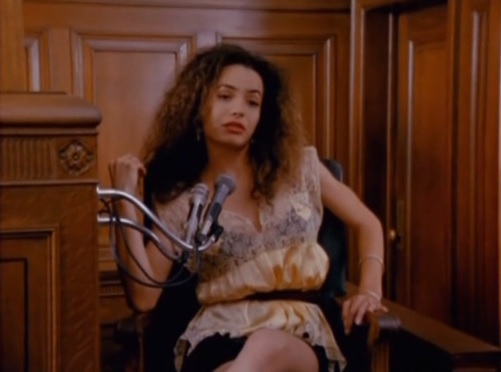
Adam: Is there different preparation for a small role like that, or the role that you had in Judgment Night around that time, or is it a fairly similar process no matter the size of the role?
Galyn: For me, it’s similar because you’re portraying the human being. You get a lot of details from the script and then because of my creativity of being an artist, my imagination will automatically start to fill in ideas and choices about the character. I’ll start filling in, No, no, maybe not that. Maybe she’s that way or maybe she, and then I’ll decide, Yeah, that’s what it was, she was raised by her mother and then the father left, or no, she was raised by two parents, then I’ll start saying, OK, yeah that will be it. Sometimes I’ll get really specific, OK, her favourite colour – it’s fun, that creativity just to create this person, this human being, and then just to play in that field. But it’s pretty much the same process, no matter how big or small. At least it is for me.
Adam: I was talking to an actor about this recently because I do work on empathy and how we take other people’s perspectives. I guess that’s really the height of acting, isn’t it? It’s really getting into someone else’s skin as much as you can.
Galyn: I always feel the compassion that I have for people and world events when I watch the news, I attribute it partially to being an artist and being an actor because you have to have empathy for a character no matter who they are, if you’re going to portray them, so it really teaches you a lot of empathy. I agree.
Adam: I really liked the role you had in Judgment Night with Emilio Estevez where you’re playing this woman that those men who come into her apartment have a very particular perception of who she is based on where she lives and whatever else, but she’s not like that. She might be living in what they would see as I guess a ‘dump’ of a building, for want of a better term, but she’s paying the rent, she’s looking after her daughter, she’s looking after her sister or whoever it was. I thought that was a really interesting role for you.
Galyn: That’s true, the stereotype. I mean when they first come upon me, I’m afraid of them and they’re afraid of me in a way. We’re both kind of like wild animals, kind of trying to sniff the other one out, sense if it’s dangerous. But you’re right, if you go to certain parts of Los Angeles that are, quote-unquote, “urban ghetto areas”, and you drive in those areas – I’ve been in a lot of those areas because I have a grandfather who used to own a tyre shop, he just got rid of a tyre shop in East LA – and it is, there’s a lot of that run-down part of the community, but then you have houses with grandmothers and aunts and people and they’re doing their jobs and you think, Well people don’t see this, that it’s a mixture of all of those things.
Adam: That’s a very good point because they were like the well-to-do, whatever, they kind of thought that they were the ones who should be afraid of other people, but it’s interesting it kind of went the other way with her. She didn’t know who the hell these people were.
Galyn: Right. Living in an area where she was, where there is a lot of violence and there’s a lot of betrayal and there is a lot of violence, you would be, if they came up – even if they didn’t look like they were from her neighbourhood or area – you know you’ve got the guys coming up, she had a bat already there to go take out her trash. She was used to living in, you know having to live in, defending herself and being prepared because of violence in the area.
Adam: In 1994 you got your first regular role in a scripted TV series with M.A.N.T.I.S. What was your experience on that?
Galyn: Well, we shot that up in Vancouver, so I went up to live in Vancouver. I love Vancouver. It’s so beautiful up there, the water and the air. Well, one of my co-stars, Christopher Gartin, the young guy on the show – it’s so cool, he and I just connected on Instagram.
Adam: Oh, fantastic!
Galyn: Yeah. We hadn’t talked in a while, so that’s great. Roger Rees passed away not too long ago, the English actor. He was such a sweetheart, and then Carl Lumbly, gosh, he was great to work with, Adam. I lost contact with him and I’ve tried to reconnect with him, but I just haven’t been able to yet. That was a TV series, so lots of hours, lots of days.
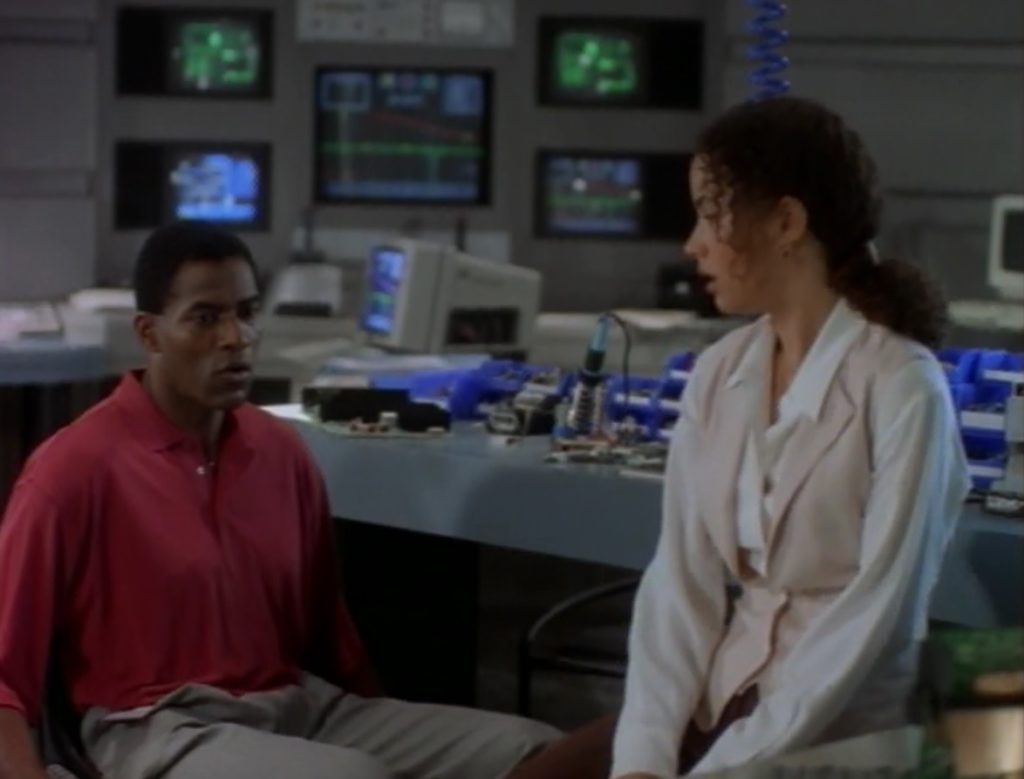
Adam: There was an interview in one of the papers at the time, where you said you liked filming there because of the relaxed people, the clean air, the clean water, and the trees, which is probably your Hawaii upbringing as well coming in there.
Galyn: Yeah that’s true, I always appreciate that. Bryce Zabel, one of the producers, and Sam Raimi, that was their baby at first. I enjoyed it because I love any – it’s like sci-fi, even though my character was a detective, I was still involved in a sci-fi show, so that was great. They don’t re-run that show in the States anywhere, but it does re-run in parts of Europe and different parts of the world. I always like to be connected to sci-fi, and it was wonderful being on a series because all these guest actors got to come in, so you got to work with all these different extraordinary guest actors, which was a blast.
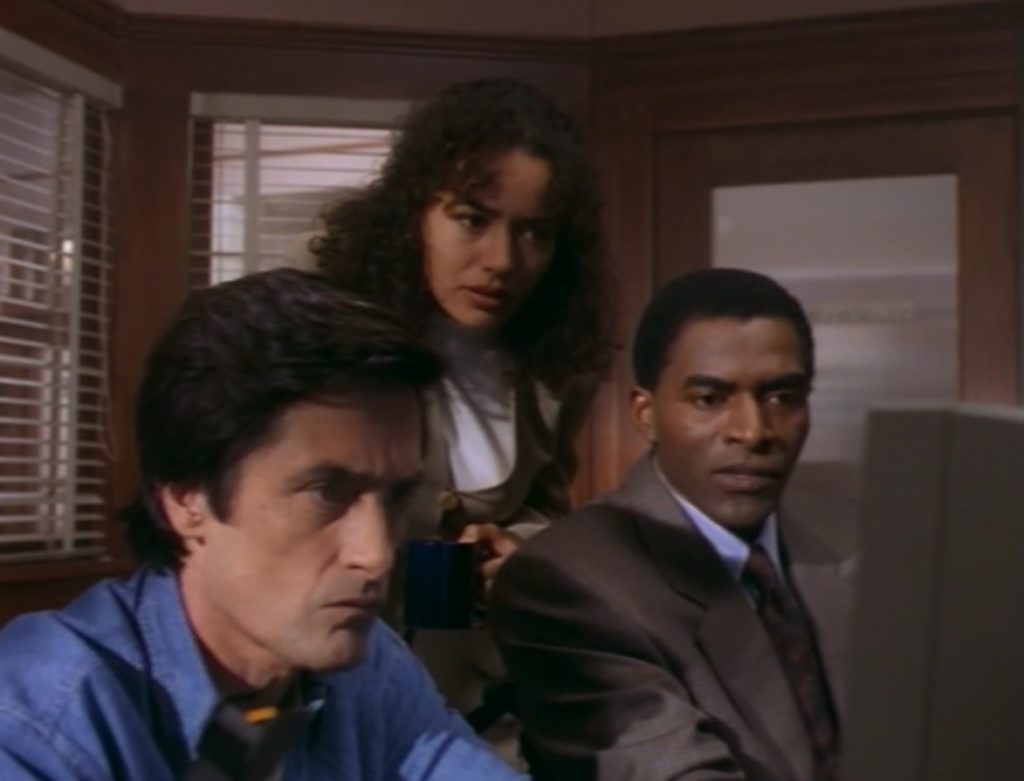
Adam: Was Sam Raimi involved in it when you came on, or he had kind of created it and sort of left?
Galyn: He had kind of created it and left. I don’t really know the backstory. Well, you know they re-cast my character and then that’s when I got the part. But then Sam Raimi, I guess went on to other things. I don’t really know the backstory on what happened. Kim Manners directed quite a few episodes. I found out recently that he passed away. He was involved in The X-Files. When I think of Kim Manners, he was like a mad scientist when he was directing.
Adam: That’s a great visual, I love it. It’s interesting because around the same time [as M.A.N.T.I.S.], there was Scully from The X-Files who, similar to Leora, was this strong scientific woman – maybe not scientific in the case of your character, but sceptical voice of reason.
Galyn: Yes, because my character was a detective. We came on the second year of The X-Files. We aired before them [on Friday nights] during their second season. We thought this show was going to keep going because the ratings were doing well, but there was something with the studio that they decided to cancel it. My character was kind of the Lois Lane to the superhero, kind of sceptical, kind of wanting to really have the facts and details, the scientific proof, and solve the crime.
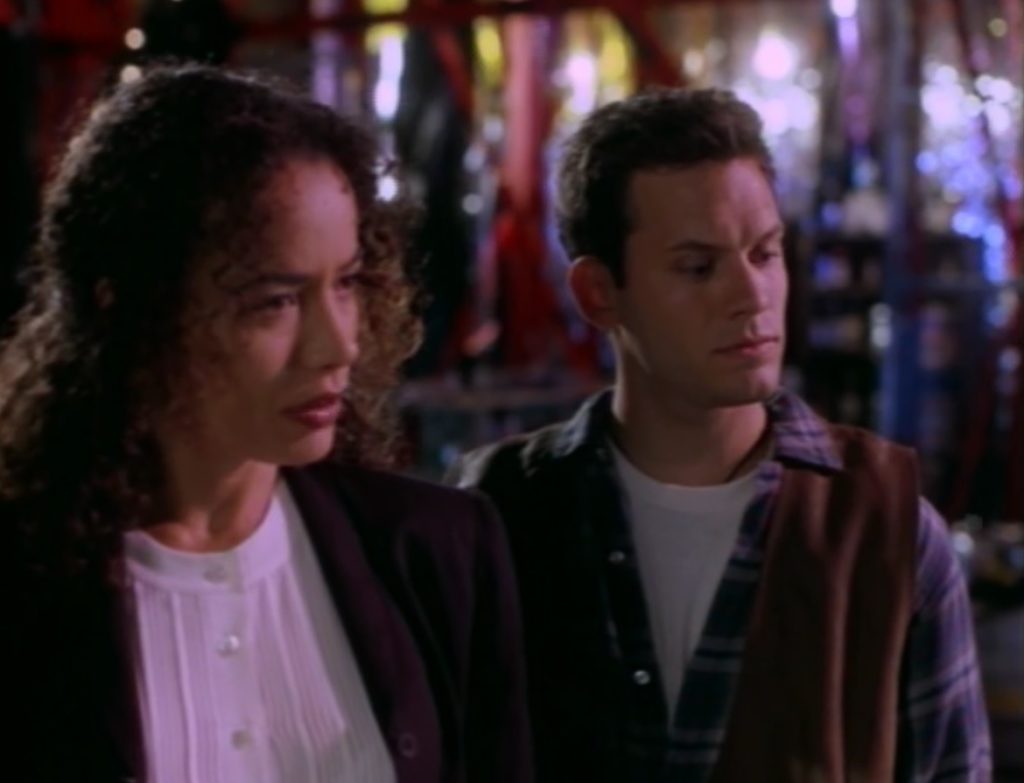
Adam: We’re going to talk about a lot of your science fiction work. I think what I really liked about that show is that even though the scripts went for that kind of science fiction, it still dealt with very topical issues like all good science fiction does. For example, there was the pharmaceutical episode where the kids had been given some sort of drug to make them more attentive or smarter, or whatever else, but it was having all these side effects. It was that whole idea of drugging up the population. Then there were stories about biological warfare. I think that was a very appealing part of that program. I don’t know if you remember, but towards the end it started integrating a lot more fantasy into well.
Galyn: You probably remember better than I do. [Laughs]. It probably did. You are probably right. I’m just trying to remember. I may have seen some of the episodes, but I don’t know if I even saw every episode. I think when they aired maybe I saw them. I remember the show from reading the scripts. I saw recently on YouTube a scene and I was like, I don’t even remember doing that scene, when my character goes to a psychologist or a counsellor, so it was interesting watching that. It may have gone into that [fantasy]. I don’t remember, exactly. I bet you talk to a lot of actors like that. [Laughs].
Adam: [Laughs] Yeah, they’ll ask you, “I don’t remember that at all. Was I good in that scene? I hope I was”.
Galyn: [Laughs].
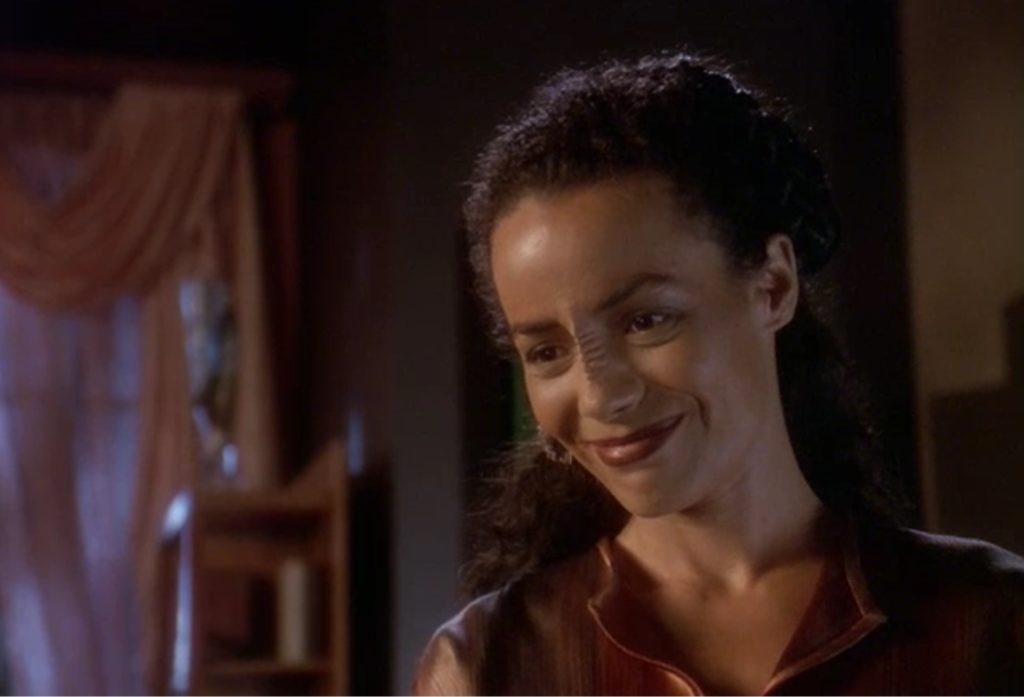
Adam: While we’re talking about science fiction, this probably fits in quite well. You had a very sympathetic role as Tony Todd’s wife in Star Trek: Deep Space Nine. Once again, the good thing about science fiction is that it can be quite topical, and I like what it said about healing, or in this case not healing, from the grief of him losing his father. It was also a very clever script because it had that touch of the reclusive author, the whole J. D. Salinger-type thing. Do you have any stories from that show?
Galyn: I’m trying to remember. I know one thing, first of all, I was a Star Trek fan, my brother and my sisters and I watching the original with William Shatner. So, when I was cast on Star Trek, I was like, Yay! It was almost kind of surreal, so that was exciting right away. I was at a Star Trek convention in Vegas, it was almost two years ago, and people came up to me because I didn’t know that that episode that I did of that series is like one of the most recognised episodes of the series. I had no idea, and people came up to me who said, what you’re saying, the way the story was told, it really moved people and touched people. The story, it really meant a lot to a lot of people. I knew it was different than, you know, Star Trek is that series, all the series, you know there’s always the sci-fi and then there’s the battles and all that, but then they always touch into different parts of the human emotion and human experience, and so that episode really touched on that. I found out later that it was so moving to so many people because at the convention the Trekkies kept coming up to me and having me sign things and thanking me for coming, and that episode, they would tell me it really touched their hearts. That’s when I really learned about it. When we were shooting it, I knew the scenes were meaningful, but then I learned afterwards how much.
Adam: You had some really beautiful scenes in being able to draw out that character of the wife who’s very, she’s very supportive of her husband and understands in some ways what it must be like for him. When he’s meeting his father again for that first time, you can just see how nervous you are for him because you’re so concerned for him. It was really beautifully done. I’m not surprised to hear that it is one – I’ve read that quite a bit, that it’s one of the top episodes for people who like Deep Space Nine.
Galyn: You know, I was going to say, Tony Todd – whenever I’m in LA, we keep talking about getting together for lunch and it just never happens, so he and I were messaging yesterday, I think. I said, “I’m in LA”, and we keep talking about “OK, let’s get together for lunch”. I’d be curious to ask him, I’m curious as to what his experience was on that shoot, what his impression was of that scene and those scenes in that episode, because I’m sure he has a perspective, and he’s probably asked all the time, too. Yeah, now that you bring that up, when I meet with him, I’m going to ask him about his perception.
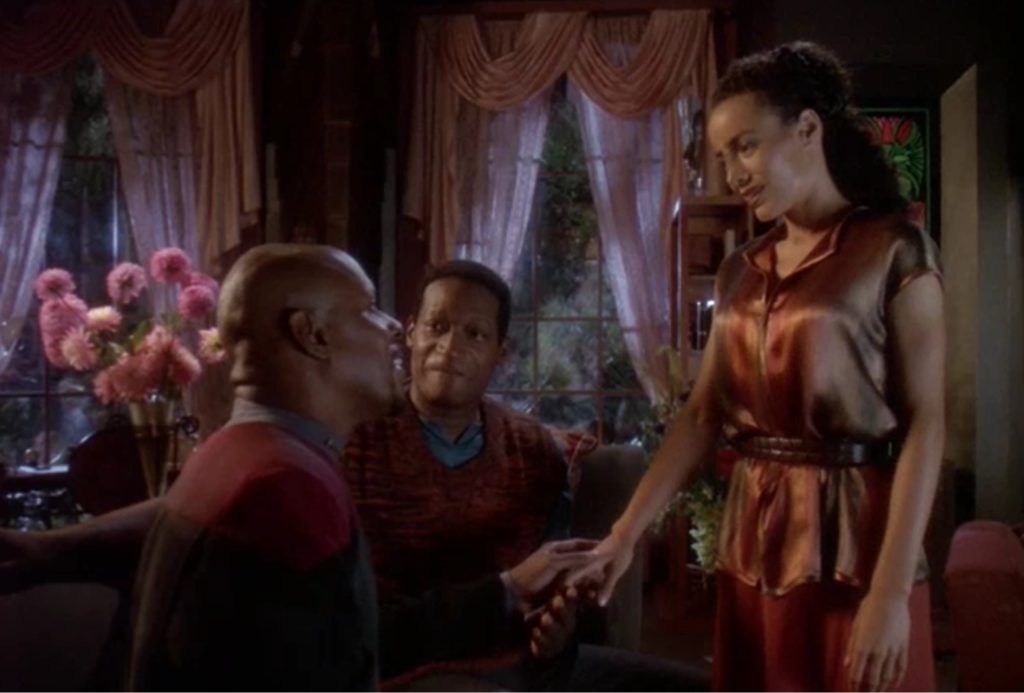
Adam: You also appeared in Voyager, as well, as Nori.
Galyn: Yes.
Adam: Was that a different sort of experience working on that program? You mostly worked with Jennifer Lien and Anthony Crivello.
Galyn: I remember my outfit because my costume is always very important to me, and my outfit was very kind of confining and very structured. It was a completely different type of character; the story line was completely different. I remember the sets – I’m picturing it. It was such a different character because when I was on Deep Space Nine, she was just so much more nurturing in that mothering kind of person, and this character was so different. She [Nori] was kind of in a powerless position.
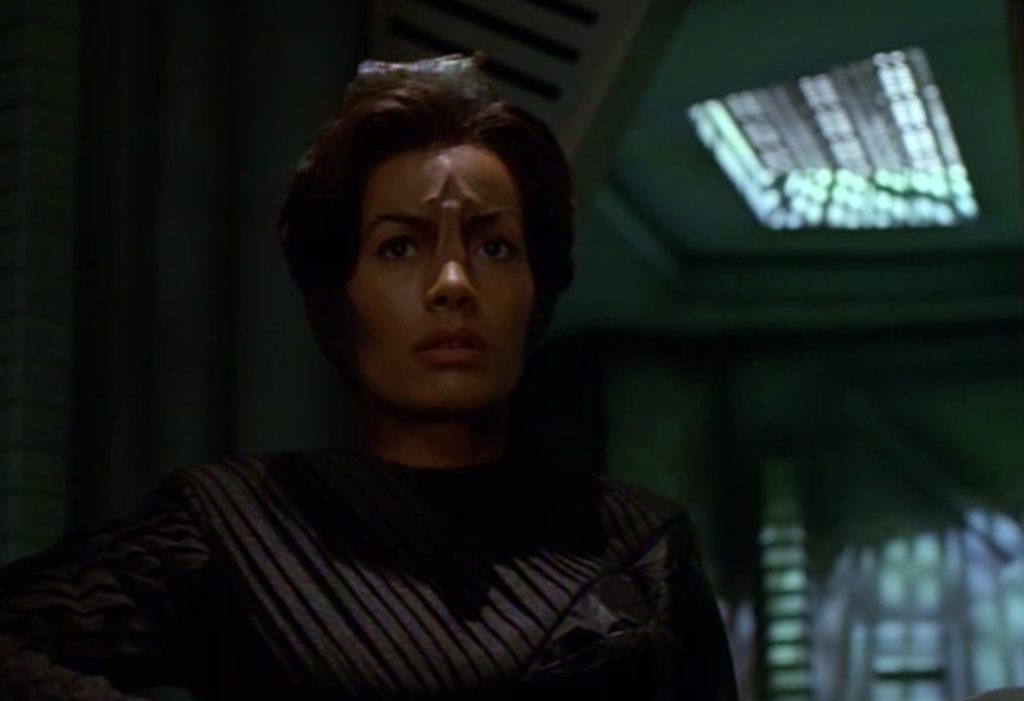
Adam: When you say that, I’m thinking of when you played Helen of Troy on Xena and your take on that character. To some extent, she was very powerless, until she finally tries to find out who she is towards the end of the episode.
Galyn: Yeah, that’s right. There’s a scene – I actually put it on my reel – where I’m yelling, and the character is saying, “Don’t you realise what you’ve done? You’ve killed your own brother and ruined Troy. And for what?”, and she speaks out and uses her voice, so there is a transformation that happens there. By the way, l loved the costumes. I loved what I got to wear in that one.
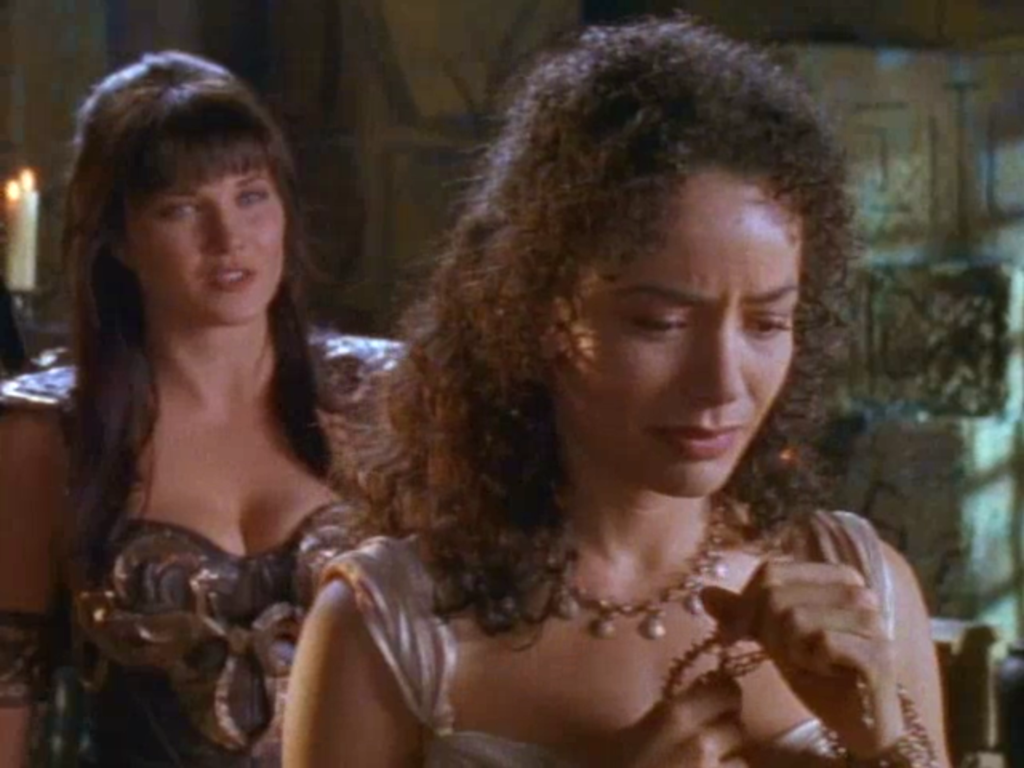
Adam: And they were fun programs – Hercules, as well. Were they fun programs to do: Xena and Hercules?
Galyn: Yes, those were fun. First of all, I got to be flown down to New Zealand because we shot in New Zealand, so they flew me down to New Zealand. Those were Rob Tapert and Sam Raimi. Lucy [Lawless] was great, and Kevin Sorbo’s a jokester, he likes to play jokes. Those were fun because the costumes – it’s so over the top, it’s such make believe, but when you’re in a scene, you’re really taking it seriously as an actor. But yes – it was almost like you were dressing up for Halloween, it’s like a make believe, like children, you’re really playing.
When I shot Hercules, Anson Williams from Happy Days was the director. I saw him at the Star Trek convention when I was there, and we were talking about that episode. And I remember Kevin Sorbo we were on set and I played, On Hercules, I played an Egyptian princess and I had to hold a cat. I’m allergic to cats, but I was able to do the scene quick enough, so it didn’t bother me that badly. I remember Kevin saying some joke and we were joking. I barely knew him, and he started chasing me – we were chasing each other around the set laughing and stuff, and then we started shooting again. He was sweet. And Lucy, somehow, I needed a ride somewhere. I don’t know why I needed transportation and she was like, “I’ll give you a ride”, and so she and her daughter, who’s probably an adult by now, gave me a ride, and she was just a sweetheart and gave me a ride, and we barely knew each other. It was just fun. I had a great time down in New Zealand. I took my grandmother with me, so we went exploring. We were down in Auckland. Yeah, it was great.
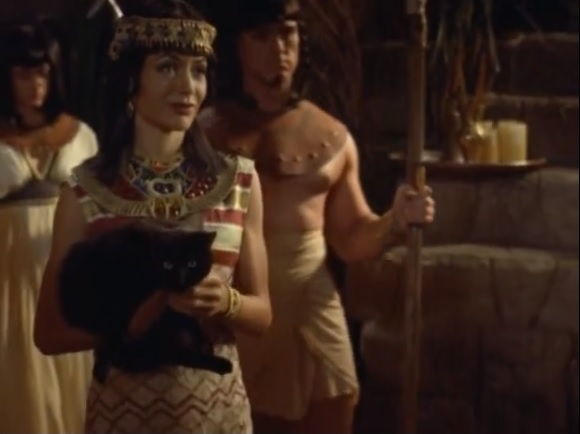
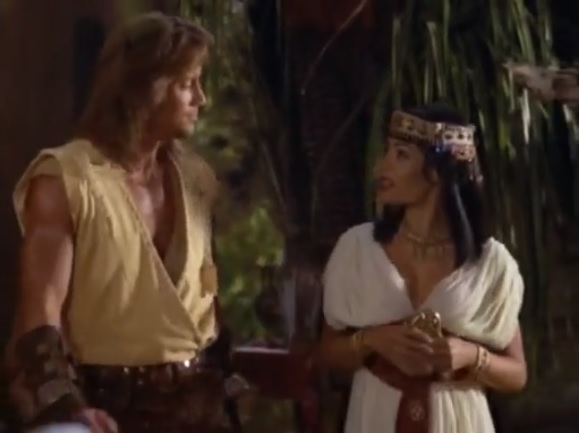
Adam: You’ve done better than I have. Obviously, Australia is very close to New Zealand and I’ve never been, so that’s another place that needs to be added to the list.
Galyn: That’s right! You’ve got to go.
Adam: And those shows were very big down here when they were on – they were kind of staples of the Saturday night schedule. That’s great to hear that they were fun to do. They’ve got quite a cult following. Star Trek has obviously got a massive following. Like we were talking about with Deep Space Nine and fans thinking that your episode is one of the best, one of the favourite episodes of The Fresh Prince of Bel-Air fans is the episode you did: “Boxing Helena”. Were you a fan of that show when you got that role? Had you watched it?
Galyn: Yeah, I had watched that show. Of course, Will Smith, he had been doing music before, and I liked him. Everybody loved him. I went to NBC Studios out in Burbank to audition for that. I’m trying to remember – what happened in the room? There was a producer and a director, and the reading went really well, and then I got it.
It’s television and you have studio audience, so we rehearse all week, you know Monday through Thursday, and then rehearsal Friday, and then tape Friday afternoon, early evening. The thing that was great about working with Will is that he liked improv, so he goes off the script. You know, we have the script, but then we’ll be in the middle of a scene, and if a creative idea – as an artist, if you have the opportunity – he would go off the script and play with ideas or change something during the scene. So that’s what was great about shooting that.
We had a scene in the boxing ring. He and I have a scene, and so he started improvising and so I started improvising, and I made up some part of that scene. I think the “bwak bwak bwak” – the chicken thing – I made up that. I made up some part of the scene, and they kept it. It was fun working with him. And I knew it was a good episode. You know when you asked if you know – and I don’t always know, but I remember before we taped, he called everybody, the whole cast had to come into his dressing room and we all got in a circle and we did like a focus, energy positive. I don’t know if you want to call it a prayer or whatever, kind of “Everyone focus”, and he said, and whichever other regular on the cast – I don’t remember – said, “Oh, we’ve got a good episode. This is a good one”. Because they do so many, but they knew it was a good one. It was a funny episode.
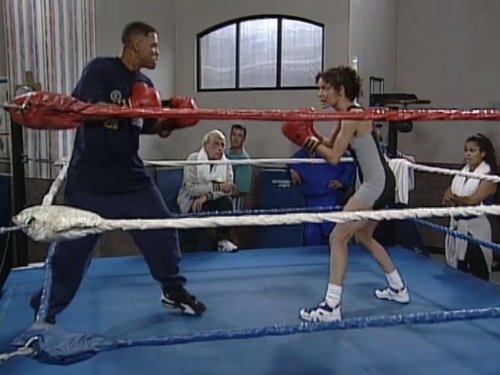
Adam: Do you like the chance to do that improv within a scripted program, TV show?
Galyn: I liked it. If the writers are open and are confident enough to let you kind of play around with it because it enhances the story and the jokes, it makes it so much fun.
Adam: I imagine that a lot of being able to improv also comes from having the preparation, knowing what your script is, knowing who the character is, so that you can kind of go in a direction that might be unexpected but makes sense from the point of view of the story and the characters.
Galyn: Yes, exactly. You don’t want to veer off the storyline or veer off the character, you want to stay within those parameters. It’s like I’m a dancer, I have ballet and I have modern, I have jazz, I have all these techniques, but when you perform you kind of throw in your own flair and your creative artistry comes through, so it’s the same. You have the structure of the script and you have the idea of the character. You play within that.
Adam: I love the way you’ve described it, that use of self, even within a technique you’re still using yourself and what you know and what you bring to it. Let’s talk a little more about science fiction and fantasy because you’ve appeared in quite a lot of science fiction, and I know you said you quite like it. Is that a case of you being asked to play those roles, or they appeal to you, so you audition for them, or something else?
Galyn: It just seemed to kind of happen. I think one of the reasons is because of the way I look. If you audition, they call it “ethnically ambiguous” some of the time, and so it seemed like in the sci-fi fantasy genre – I seemed to fit in there and it was acceptable, kind of this ethnically ambiguous. That’s what I’m thinking, Adam, is what happened, but I like it, I like the sci-fi fantasy stuff.
Adam: One of the shows you did that we should talk about is Stargate SG-1. Like any good science fiction, your episode dealt with very human themes. You had the lead role in that. You played Kendra, who’s a healer, but she’s been ostracised because she was taken over by one of the Goa’uld. I felt it was really interesting that Kendra speaks of being restored to her true self and what she used to be, her voice within and facing fears, and there’s a whole lot of that sort of metaphor and allegory. There was an allegory with race a little bit, in that she sought to separate herself from those who had done wrong. I thought that was a great role for you. Did you enjoy doing that one?
Galyn: I did, and I think that’s one of the things that’s so great about sci-fi, fantasy, that kind of thing, because on so many projects that I’ve done there’s always this, there’s either commentary, or it seems – yeah, there’s a lot of delving into deep human conditions. I just love it.
I had a great time [on Stargate SG-1]. We shot that in Vancouver. It just felt like it was like a dream come true in a way, just being able to have the character and tell that story and have that kind of character with that background and that dialogue. The director, Brad Turner, he was great. And the actors – everybody was nice and kind. As I talk to you about all of these, I realise, Wow, how grateful I am that I’ve worked with – I’ve always had such good experiences. Everybody was so welcoming.
I loved my costume, by the way.
Adam: [Laughs].
Galyn: I loved the dress. I’ve got a Polaroid of me standing outside the costume wardrobe trailer in my dress, holding up my arms. I got to have the cape – OK, so I loved my outfit [laughs].
Adam: [Laughs].
Galyn: It’s always important. My sisters, some of the first things they’ll say, “So how’s your costume?” [Laughs].
Adam: [Laughs] I love that.
Galyn: That was an incredible costume.
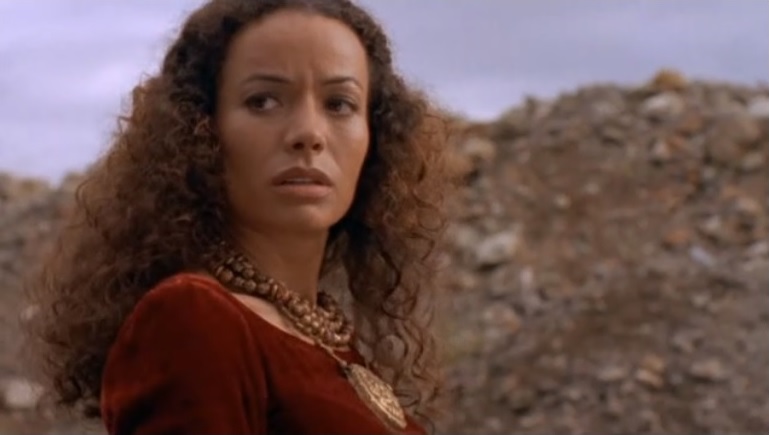
Adam: When you come onto an existing program, do you generally find that the actors tend to be quite welcoming to their well-oiled machine?
Galyn: They usually are. I can think in my mind of one – there’s probably been more – I can remember an episode of a show that I worked on and they weren’t, but I won’t mention – I’ll always say the positives because I won’t mention the ones where it wasn’t. I don’t know, it wasn’t super welcoming, but usually it is. Usually, I find that it is. I’m real open and not standoffish, and I’m like, “OK, I’m a professional artist, we’re all professional artists”. Like when I worked on Colony recently, Josh Holloway and Sarah Wayne Callies, right away, because I met them at lunch, they were like, “Hi, welcome, sit with us”.
Adam: That’s really great. I like that focus on those experiences, and let’s forget the other ones that weren’t so fantastic.
Galyn: Yeah, yeah.
Adam: It’s funny you talk about the costumes, as well, because a friend of mine, Donna [Loren] who worked a lot in the ‘60s, when she was quite young – I ask her sometimes, “Do you remember doing this show, or this song, or whatever, and she’s like, “I don’t, but what was I wearing? That might help me remember”.
Galyn: Right! [Laughs].
Adam: You took a bit of a break, or you scaled down from work, around the early-mid 2000s. Was there something that led up to doing that?
Galyn: Well, Adam, you call that a marriage and a divorce.
Adam: Ah, that’ll do it every time.
Galyn: That’ll do it, Adam! [Laughs]. Yeah, I got sort of sidetracked. I got into a little bit of some challenge, challenges. I mean, I never stopped. I continued to take classes to a point, and I continued to dance, but everything kind of got really challenging at times, so that’s when I kind of had that break. I didn’t mean to, it just kind of happened.
Adam: I speak to a lot of actors who often take a break, for lots of reasons. I guess in your case it was just that kind of other things were going on and it’s not necessarily that you mean to take a break, but you just move into another part and things happen; and sometimes if things are a bit chaotic, or whatever else, your attention is sort of elsewhere.
Galyn: That’s pretty much what happened.
Adam: As you said, during that time you were still going to class and so on. Were you in Hawaii around this time?
Galyn: I was in Los Angeles a part of the time and then I was in Hawaii part of the time. I was in Los Angeles and just got sort of sidetracked into a whole different kind of journey for a while, and then I was in Hawaii for a little while. I’ve been slowly kind of getting back into the industry, and I’ve started to get some traction again, which is good.
Adam: Fantastic. From a practical point of view, is it difficult once you’ve been out of it for a few years to get back into it?
Galyn: Well, it can be because you have to have some current credits to really kind of get in there. My resume is extensive, so getting representation is not usually difficult. I actually just signed with a new team, Media Artists Group, which is great. It’s funny that I’ve started my social media pages, Instagram and Twitter, and I’m on Facebook, too, and that’s where I’ve been contacted by different people in the entertainment industry.
Adam: You were on the last episode of Parks and Recreation. What was that like?
Galyn: It’s so funny how sometimes things just kind of happen. I just got a call, “Galyn, you want to do this?”, and I said, “Yes”. I had a small scene – I hadn’t done anything in a while. Being an improv – I’m part of the main company of a group called IFTP, Improv for the People, in Los Angeles – so if they say Amy Poehler, I’m going to say, “Of course”. You can YouTube and watch her do improv, and she’s just phenomenal, so I was like, “Yes!”.
I had a little speech on there, but my interaction was with Amy, and she was great. I remember the scene we had, we didn’t talk about it, but there was a cue that I had to give her in there, and it was so cool because I know what she was expecting as an improv artist. She’s a genius comedian, a genius improv artist. When I told the other people at IFTP [about the role with] Amy Poehler, everyone was just like, “Wow”. She’s held in high esteem as an improv artist.
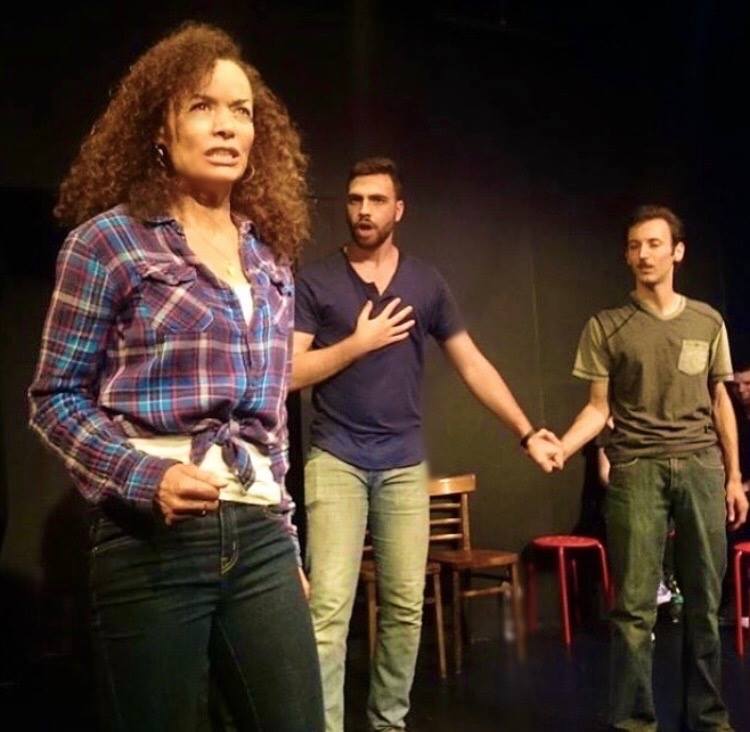
Adam: It’s interesting what you say about people tracking you down on social media. I think even David Lynch put it out to social media to try to find Everett McGill when he was doing [the new] Twin Peaks and couldn’t find him anywhere. What I particularly like about what you post is, like you said, there’s the film stuff, there’s the TV stuff, but then there’s a whole lot of other things. You strike me as someone who’s very committed to self-reflection and development. Is that something that you’ve actively pursued or is that something that came over time investigating different, I guess, modalities, for want of a better term.
Galyn: I think it’s probably because of my parents and their background. I mean, of course I love having success and being prosperous and being well, but at the same time I also want my piece of mind, and I want to be able in this wild, wild world, to find, you know, so I am a voice, what I put out there, what I share is something that maybe helps someone else also be happy or create some peace or some beauty. I consider myself a performance artist, a dancer, so I like to do different poetry, images, and I post them on those platforms.
Part of the missing years around not acting, I spent much time with the Lakota and the Diné and the Hopi, different Native American tribes, and so in that time when I wasn’t acting, I was spending a lot of time doing different ceremonies and different practices and different teachings. That’s one of the things I was doing. Images of beauty in the Native American – there’s a saying, the “beauty way”, it’s the beauty way, so anything that I can do to bring beauty into the world into the world, and compassion, I think it’s a practice.
Adam: And you also teach and work with children. How has that been?
Galyn: Yes, I’ve done a nice amount of that. In those years when I wasn’t acting, I taught quite a few workshops all over the Los Angeles area. I’ve done dance, I’ve done theatre. It’s all arts education. I’m starting to put together all the footage – I have so much footage of working with youth. And that’s part of my heart. I have another project I’m developing. It’s kind of a book, it’s based on the – I don’t know if you know from the ‘70s, it was called Free to be You and Me.
Adam: Of course.
Galyn: Marlo Thomas did it, it’s based on that format and it’s really good. I’ve got so much material already compiled. But working with young people from, you know, I’ve worked with gang members, probation kids. I’ve worked at Hollygrove where Marilyn Monroe was when she was young. I’ve worked with wealthy kids and poor kids, all over the LA area, and I love it. I’m good in the room with them, and I think, from what I’ve learned, I’ve helped a lot of young people and they’ve helped me, too. I enjoy it.
Adam: That’s fantastic and I love that idea that you get as much from them as they get from you. And you do see that, the kind of effect that you can have on people. Sometimes with what I do, I write, it goes somewhere, and it disappears for how ever many months and by the time it comes back it’s almost that delayed gratification. But when you’re in the moment in a classroom or somewhere else with people, you kind of see people “getting it”, and they get it in that moment and you get that feedback, sometimes quite immediately.
Galyn: It’s so true because I’m in there for arts education, but what I was taught from a lot of the arts organisations is that what I’m bringing in there is important, but in the present moment whatever is happening with the young person in there, whatever issue or whatever’s going on with them, that is more important than anything.
I’ve taught little ones all the way up to high school. The population that I didn’t know would be receptive to me is these high school boys. I thought, Oh gosh, I could never teach high school boys, but I taught in the last two years and, Adam, they were some of my favourites. I taught at an education centre and these young men, African American, Latino mostly, they just were so receptive. I had such a great rapport with them. Man, we had a lot of fun. If you have something interesting, they’re just sponges to learn and want to improve. They have so many dreams, and you’re just helping them believe and bringing out their potential that has to be cultivated, it has to be guided in the right direction I just really loved working with them. I didn’t know that I had the ability and it was just great to do that.
Adam: That’s so interesting what you say about getting them to believe because I think sometimes when you come from parents or families who have given you that, when as you’ve grown up they believe in you, they make you believe in yourself, you kind of think that must be the way that everyone has it. But there’s so many people who never had that foundation to begin with, and so it really has to be nurtured in them and treated as something important and special.
Galyn: It’s true because if I stand in a workshop and I ask, “Everyone raise your hand if you have someone in your life that’s telling you you’re stupid or making sly comments, or [telling you] that you are not smart, you’re stupid. Raise your hand if you have someone in your life like that”. Usually everyone raises their hands. So, to be that voice; it was wonderful.
Adam: Dance is still a very important part of your life. How has your identity as a dancer evolved over time, has it evolved, has it changed?
Galyn: I took two classes yesterday, that was three hours involved. I did a lot of Brazilian samba and then dancing the different Brazilian styles. Dance, oh my gosh, Adam, the thing that is so great because I’ve danced for so long, going to the different cultures and different styles of dance from the ballet to the modern, I did some tap, into jazz, I took a little hula, but I’m not considered a hula dancer. You know, when I was in Israel, I went into dance class; when I’m in Vancouver, I go into dance class, wherever I go – when I was in New Zealand, I jumped into a dance class. Wednesday night, I’ll probably go take a West African dance class, Thursday night, I might take a contemporary. Just to be able to express, it’s just – I’m trying to think of the question. I mean, it’s always been good, and it always gets better and better. It’s so fulfilling, and if I’m down or not feeling good, if I walk into a good dance class I will walk out, and I will be transformed.
Adam: It’s almost like, “Build her a dance studio and she will come”
Galyn: Yes! [Laughs].
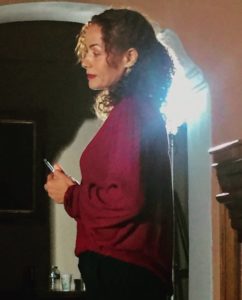
Adam: Acting wise, is there anything you can talk about that’s upcoming or in development at the moment?
Galyn: Yeah, I shot another TV movie. I play a psychologist. It’s called The Wrong Crush. I’m talking to my agents because I’m meeting with directors right now. I’m meeting with a director and then a producer next week. Because of improv, I really want to do some character work, so that’s what I’m putting out there. I’ve quite a few characters developed. My management asked me to put the characters on tape because I’ve got quite a few. So, I’m meeting with some directors and producers, and we’ll see what happens.
Adam: I look forward to seeing some of it.
Galyn: Yes, and in terms of some of the projects I’m working on, my youth project, I want to complete that. I think young people around the world will really appreciate it. I think it will speak to them.
Adam: Thank you so much. I’ve had such a good time talking to you.
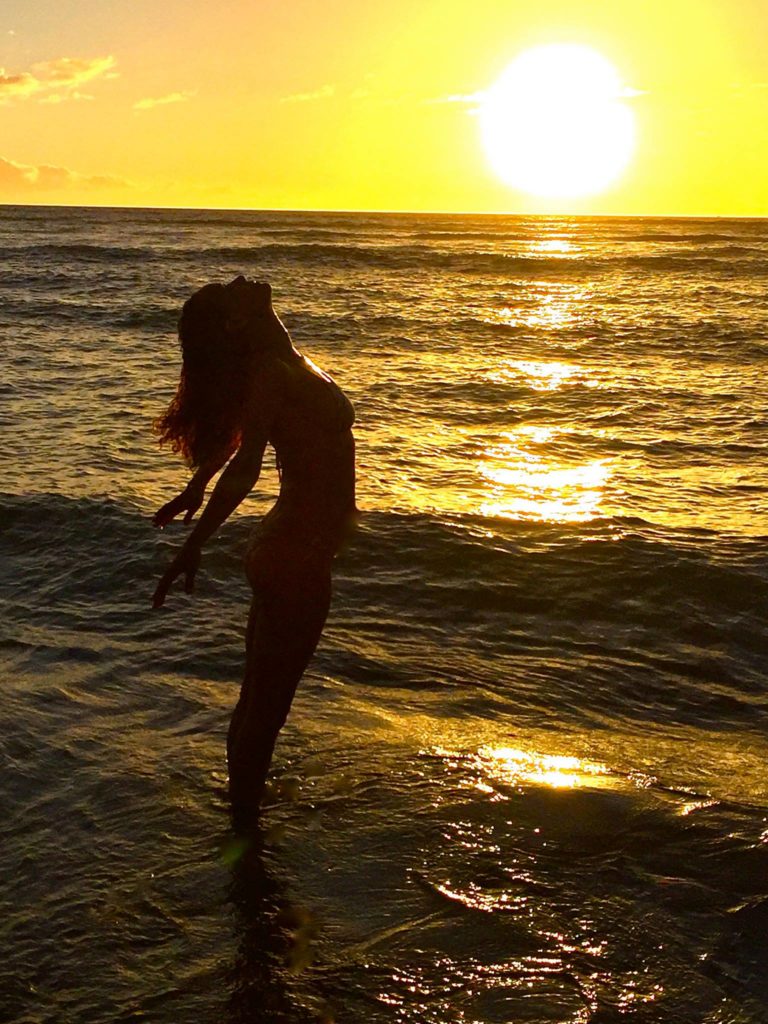
Galyn can be found on Facebook, Twitter, Instagram, YouTube, and at her website.
